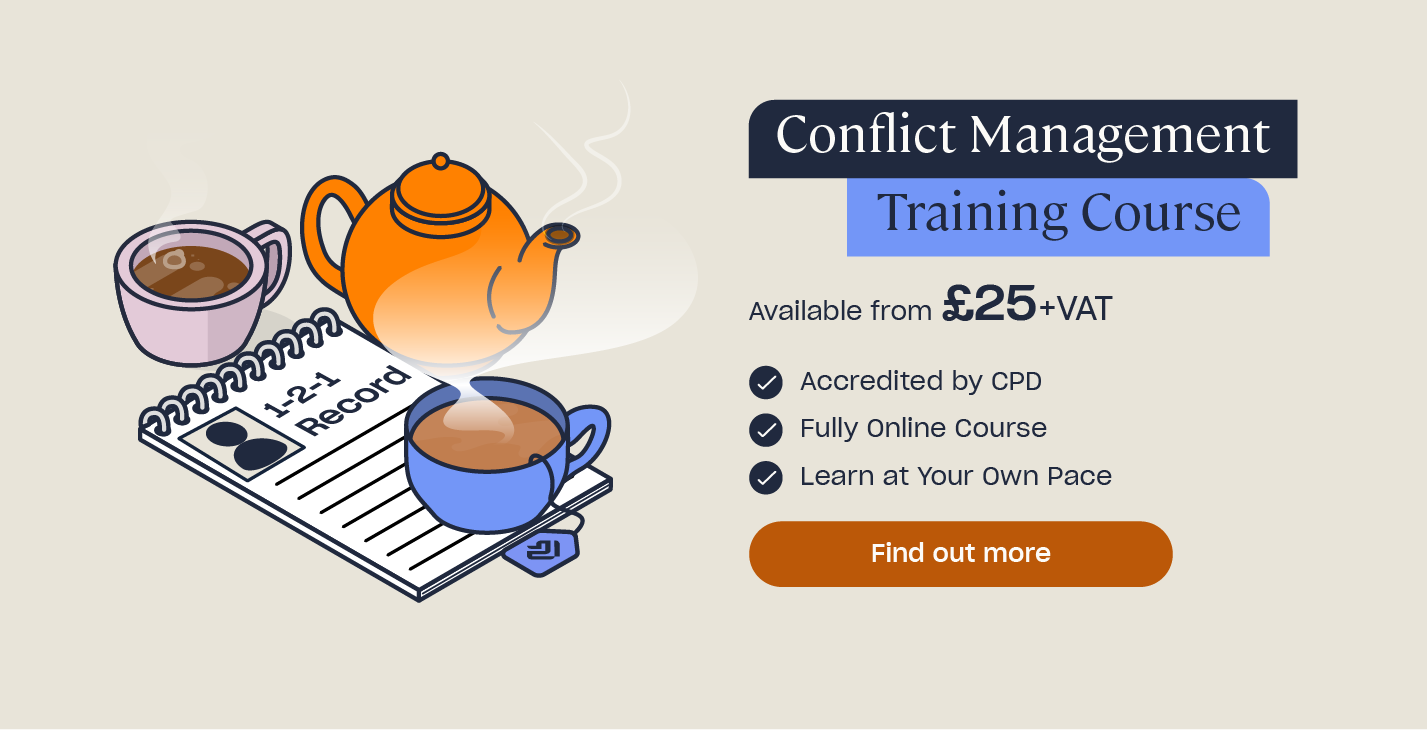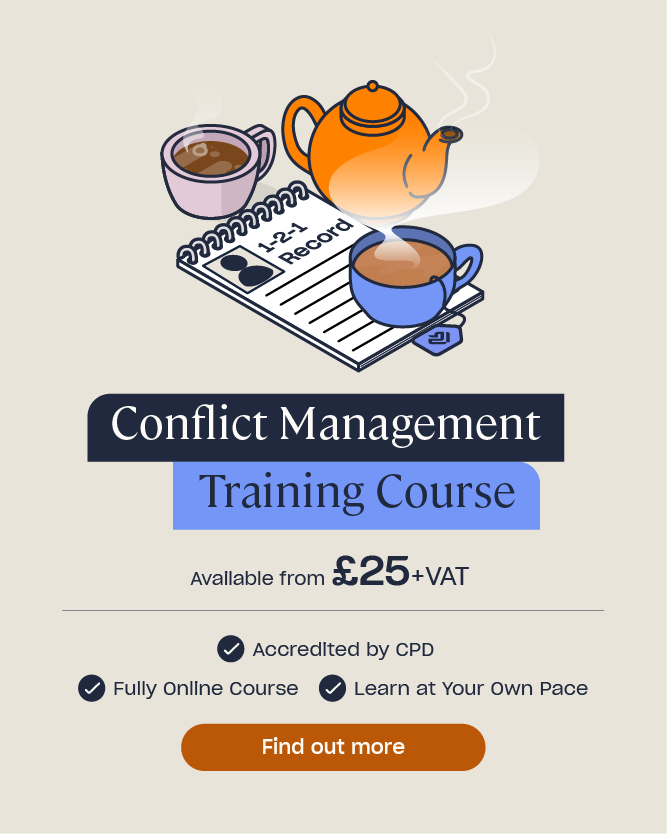Understanding the Different Types of Group Conflict: A Guide for Managers
People who work together always have differences – whether it’s their personality, style of working, or values and beliefs.
This is great because it brings various skills and perspectives to a company. But the downside is that these attributes can all be sources of conflict, which damage relationships and disrupt the natural flow of work activities.
Understanding the different types of group conflict and being able to identify signs helps you prevent or diffuse a situation. Certain conflicts require a more specific approach than others, and as a manager, you should use your discretion to decide which is most appropriate for the conflict in your workplace.

Types of Conflict
There are several common causes of conflict at work, but most are categorised by who in the workplace is involved.
The 4 main categories are:
- Intrapersonal – this is when a person experiences inner turmoil, such as disagreeing with the values of the company or being a perfectionist.
- Interpersonal – this is conflict between two or more individuals; it may be an isolated incident or an ongoing issue.
- Intragroup – this refers to the conflict between one or more people in the same group or team.
- Intergroup – these involve several different teams and are often difficult to handle without external support or preventative/corrective action.
Each of these require different intervention methods. It also takes the skill of a manager who is focused on reaching positive results, such as encouraging people to more actively respect and work around differences and help their co-workers.
Need a Course?
Our Conflict Management Training Course is designed to train senior members of staff in how to prevent and handle conflicts that occur in their workplace whilst our Conflict Resolution Course is designed for employees at all levels.
Types of Team Conflict: Intragroup Conflict
In many jobs, team members rely heavily on one another to complete tasks and projects. Low levels of conflict are natural and even healthy: they stem from creative tension and enable people to reach new, positive outcomes by overcoming weaknesses. But more intense conflicts seriously reduce productivity and morale.
There are two main types of intragroup conflict: task conflict and relationship conflict.
Task conflicts occur due to differing aims or an inability to meet the group’s standards, while relationship conflicts involve issues relating to personal views, attitudes, beliefs, and personality traits. Relationship conflicts are usually more deep-seated and harder to diffuse.

According to studies, conflict commonly occurs between an employee and their manager so it could be that staff disagree with your leadership or are dissatisfied with the level of support and resources you provide. But maybe you’re following orders from higher-ups, which can make the situation difficult to handle.
Remember: your employees are the inner workings of your machine. Keeping them tension-free means that the whole company works as it should, so you should prioritise supporting them in any way you can.
Types of Team Conflict: Intergroup Conflict
Intergroup conflicts are not usually due to personal reasons; they often stem from disagreements over how groups carry out work activities or the requests they make to other teams. It may even be a result of competitiveness. Other times, individual people in the group initiated the conflict, and other team members simply follow suit.
You must find the root of the issue to tackle it effectively, as it affects what workplace changes or alternative dispute resolution (ADR) methods are required to diffuse tension on such a large scale. It won’t be a simple case of separating people who clash: teams can’t be divided. They must work together to achieve the main goals of your company.

If not managed, intragroup and intergroup conflicts can lead to resignations or an individual swapping roles to distance themselves from certain people.
This leads to unnecessary costs and time spent on recruitment and retraining new staff.
Resolving Intragroup and Intergroup Conflict
When trying to resolve an intragroup or intergroup conflict, pleasing everyone can feel impossible. Once a team of people hold a certain viewpoint or have a preference for the way something’s done, it’s difficult to challenge. This is why you should aim to resolve conflicts through a compromise that suits the majority.
The first approach for achieving this is usually to have an informal discussion. But when a number of people are involved, this is unlikely to be sufficient. Certain forms of ADR are more suitable, and it’s up to you to assess the situation and decide what option is best.
Ways to deal with group conflict include:
- Mediation. It is ideal if you want to keep the situation informal and for people to be actively involved in reaching a compromise. Either you or an external mediator will get people to listen and open up about issues. But be aware that you need training in conflict management and mediation to effectively do this.
- Arbitration. This is a more formal approach that involves an arbitrator assessing evidence and reaching a legally-binding decision. Trained arbitrators are experienced in handling cases objectively and reaching a fair resolution. But because people don’t talk through differences, relationships may not be repaired as effectively as they would through mediation.
- Arbitration is generally better suited to large group conflicts, but mediation can work equally well with multiple mediators.
- Promote a workplace culture of openness where people feel free to share complaints about individuals or a team without retribution. Otherwise, issues behind the scenes lead to the quality of work dropping while you struggle to understand why.

People should be able to come to you with work-related problems and feel confident in your readiness to take action. This way, you have plenty of opportunities to investigate a conflict before it reaches harmful stages and can decide how to diffuse it.
Make sure that when you do step in, you communicate clearly that your and the main business aim isn’t to discipline, but rather reach the root of the issue, repair relationships, and get work activities back to normal running smoothly.
Further resources:
- Managing Conflict in the Workplace: A Guide for Line Managers
- How to Develop Coaching and Mentoring Skills
- Signs of Conflict in the Workplace
- 10 Development Areas for Managers
- Importance of Respect in the Workplace
- Preventing Workplace Violence: Employer Responsibilities
- Online Conflict Management Training







